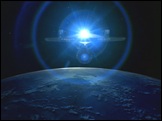|
|
Ana Sayfa |
|
|
|
|
|
|
|
|
|
|
|
Zaman yolculuğu hakkında ek bilgiler |
|
|
Çetin BAL: Time Travel Theory |
|
|
Muzaffer Kınalı: Zamanda yolculuk |
|
|
Zaman Makinesi yapılabilir mi? |
|
|
Uğur Özkanbaş: Philadelphia Experiment |
|
|
UFO Teknolojisi |
|
|
Zaman Deneyleri |
|
|
Geçmişe Yolculuk |
|
|
Rainbow Project |
|
|
Zamanda Yolculuk-1 |
|
|
Gravitik Sevk |
|
Time Travel Research Center © 2005 Cetin BAL - GSM:+90 05366063183 - Turkey / Denizli
Public
release date: 6-Mar-2002
A favorite science fiction theory, warp-drive, or the idea of space contracting in front of spacecraft, and expanding behind it to form faster-than-light propulsion is under attack according to new work by a researcher in Portugal published today in the Institute of Physics journal, Classical and Quantum Gravity. General relativity predicts that space is expanding. This can be visualized in three dimensions by imagining two points on a balloon moving further apart as the balloon is inflated. As space expands, the two points are traveling slower than the speed of light in relation to the surface of the balloon. But they could be moving apart faster than the speed of light if the distance between them is taken as the shortest line from one point to the other. Theoretical physicist Miguel Alcubierre used this idea in 1994 to make a 'warp-drive space-time'. By taking the balloon surface idea of space and contracting and expanding the space in front of, and behind a particular object moving through space, the object would be able to move faster than the speed of light. To make the space contract and expand in this way, strong gravitational fields would be required. But, such fields could only be created by large amounts of `negative energy` meaning that in classical physics terms this couldn't happen, although in the quantum world it could. In this work, Dr Jose Natario contradicts some of these findings. He imagines sliding a theoretical bubble through space, in the same way you can slide a sphere through water, and calculates warp-drive space-times similar to those found in the past. His research shows that contraction or expansion of space need not occur as it does in Alcubierre`s theory, therefore, no warp-drive effects. He finds more problems with the warp-drive scenario including the formation of what are known as `infinite blue-shifts` that suggest that the warp-drive space-time is unstable. "My work seems to imply that warp-drive is impossible even in principle - in practical terms it certainly is, as no one has any idea of how to go around making negative energy fields," said Dr Natario. Copyright © 2002 Society of Physics Students
|
 Make
It 'No': Researcher Says Warp-Drive Impossible
Make
It 'No': Researcher Says Warp-Drive Impossible